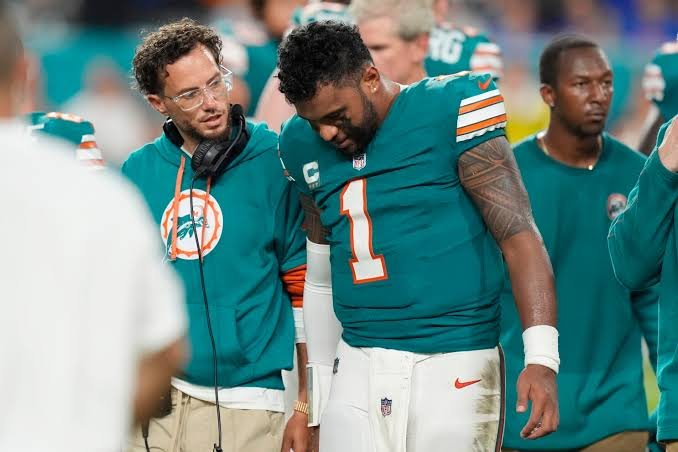# Tua Tagovailoa’s Future at Risk: NFL’s Medical Power Play
As the NFL season progresses, all eyes are on Tua Tagovailoa, the Miami Dolphins’ young quarterback, whose future hangs in the balance amid serious concerns about his health and the league’s role in player safety. Following a series of concussions and injuries, questions arise not only about Tagovailoa’s immediate playing status but also about the broader implications of how the NFL manages player health.
### The Concussion Crisis
Concussions have become a focal point in discussions about player safety in the NFL. Tagovailoa, who was drafted fifth overall in 2020, has faced significant challenges on the field, including two high-profile concussion incidents in the 2022 season. These events prompted widespread scrutiny of the NFL’s protocols and the handling of player injuries. The Dolphins quarterback’s well-being has raised alarms about the long-term effects of repeated head injuries, which can lead to chronic traumatic encephalopathy (CTE) and other severe health issues.
### The League’s Response
In response to growing concerns, the NFL has made strides in enhancing its concussion protocols. The introduction of independent neurological consultants is one such measure aimed at ensuring that players are properly evaluated after head injuries. However, the effectiveness of these protocols remains questionable, especially in light of Tagovailoa’s situation. Critics argue that the league’s emphasis on a player’s immediate ability to return to the game often overshadows long-term health considerations.
### Dr. Allen Sills Weighs In
Dr. Allen Sills, the NFL’s chief medical officer, recently spoke about the league’s approach to concussions and player safety. He acknowledged the complexities involved in diagnosing and managing concussions, emphasizing that the health of players like Tagovailoa is paramount. Sills noted that while the league implements strict protocols, the ultimate decision-making power often resides with teams and their medical staff.
This raises crucial questions about the balance of power within the NFL. Players are pressured to perform, and the competitive nature of the league can lead to situations where their health may take a backseat to team objectives. Sills reiterated that independent doctors play a key role in player evaluations, yet the influence of team management cannot be underestimated. This conflict of interest complicates the safeguarding of players’ long-term health.
### The Impact on Tagovailoa’s Career
For Tua Tagovailoa, the ramifications of these dynamics are significant. The talented quarterback faces a critical juncture in his career. Having shown flashes of brilliance on the field, his potential is undeniable. However, the specter of recurring injuries looms large. Each concussion not only threatens his immediate playing ability but also raises doubts about his long-term viability as a franchise quarterback.
The Dolphins have expressed commitment to Tagovailoa, but the reality of professional sports is that performance often dictates a player’s future. If his injuries persist, the team may be forced to consider alternatives, regardless of their belief in his talent. This creates an environment of uncertainty for Tagovailoa, who must navigate both his physical recovery and the pressures of the NFL.
### The Players’ Perspective
The broader implications of Tagovailoa’s situation extend beyond individual players. Athletes in the NFL are increasingly vocal about the need for greater transparency and protection regarding their health. The fear of being sidelined due to injury can lead players to downplay symptoms or rush back to the field, potentially endangering their future. This culture of toughness is deeply ingrained in professional sports, but it poses significant risks to player safety.
Former players and advocates have called for systemic changes within the NFL, urging the league to prioritize player welfare over profit. The debate around player health and safety is more than just a concern for the current season; it is a long-term issue that will affect generations of athletes.
### The Path Forward
As Tua Tagovailoa’s situation unfolds, it serves as a critical reminder of the need for ongoing reform within the NFL. The league must continue to prioritize player safety and health, reassessing protocols to ensure they are not only stringent but also effectively enforced. This includes evaluating the influence of team medical staff and ensuring that independent evaluations are truly independent.
Furthermore, the NFL should invest in research aimed at better understanding the effects of concussions and how to mitigate long-term damage. Player education regarding injuries and the importance of reporting symptoms is vital to fostering a safer environment.
### Conclusion
Tua Tagovailoa’s future is a litmus test for the NFL’s commitment to player safety. As he works to recover from his injuries, the league must confront the challenges of balancing competitiveness with the health and well-being of its players. The decisions made now will not only impact Tagovailoa but will also shape the future of the league and the safety of all its athletes. The spotlight is on the NFL to prove that it values its players not just as athletes, but as individuals deserving of care and respect beyond the field.

